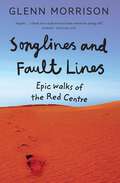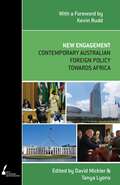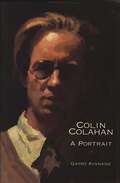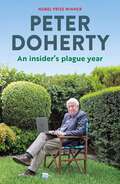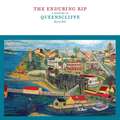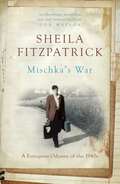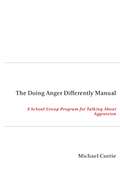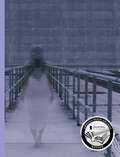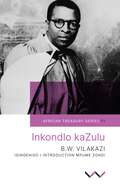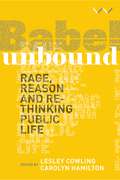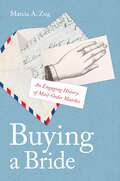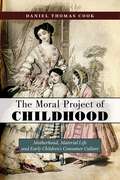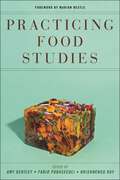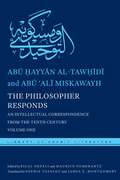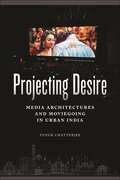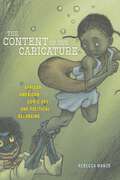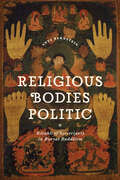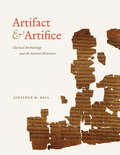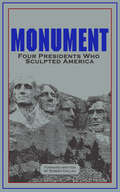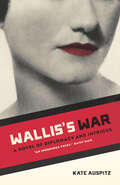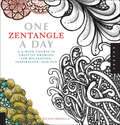- Table View
- List View
Songlines and Fault Lines: Epic Walks of the Red Centre
by Glenn MorrisonVisitors to the Red Centre come looking for the real Australia, but find a place both beautiful and disturbing. There is wilderness, desire and artworks depicting an Aboriginal philosophy of home. But there is also the confusing countenance of the Australian frontier, a meeting place between black and white, ancient and modern. Songlines and Fault Lines explores the Red Centre on foot, through six remarkable stories that have shaped our nation. It follows Aboriginal Dreamtime ancestors along a songline and trudges with John McDouall Stuart as he crosses the continent, and walks the Finke River in the footsteps of anthropologist TGH Strehlow. It keeps pace with conservationist Arthur Groom as he reimagines the country's heart as tourist playground, ponders a philosophy of walking with British travel writer Bruce Chatwin, and then strolls the grog-troubled streets of Alice Springs with Eleanor Hogan.Retracing time-worn pathways and stories of Australia's centre, Glenn Morrison finds fresh answers to age-old queries.
New Engagement: Contemporary Australian foreign policy towards Africa
by Tanya Lyons Dr David MicklerRecent developments in both Africa and Australia have brought the two continents closer together. In Africa, a resources boom, greater political stability, and the creation of the new regional institutions have contributed to economic and human development, even if many challenges including conflict, poverty and exploitation remain. Australia has commercial and political interests in Africa and, if it wants to be a significant global actor, must engage with both Africa's challenges and its growing international influence. Since coming to power in 2007, Australian Labor governments have pursued 'new engagement' with Africa after decades of relative neglect. This book, the first study of its kind, explores the key contexts for and dimensions of contemporary Australian foreign policy towards Africa. It highlights a deepening of diplomatic and political relations, a trebling of the official aid budget to Africa, and over $50 billion of Australian-based investment in Africa's resources sector, and suggests measures to make such engagement sustainable and of mutual benefit. Contributions to the book come from academics, civil servants, diplomats and politicians.
Colin Colahan: A Portrait
by Garry KinnaneColin Colahan was an Australian painter of outstanding ability and reputation who from the 1920s to the 1970s was remarkably productive. Colahan was one of the more brilliant pupils of the painter Max Meldrum. Identification with the unfashionable 'Meldrumites' is one explanation for Colahan's disappearance from the public gaze. The other has murkier origins in the still unsolved murder of his girlfriend, Mollie Dean, in 1930. There was nothing of substance to link Colahan to the brutal murder, but fevered public speculation cast a depressing shadow for many years and helped propel him to Europe in 1935. There he stayed for the rest of his long life. The story of Colahan's personal life is tantalising in itself—three marriages, five children, numerous lovers, beautiful houses in England and Italy, portrait painter of the rich and famous. It was an urbane life. He was a witty, charming, talented man. This intimate, engaging portrait is indeed most welcome, and will restore Colahan's life and work to its rightful place in the history of Australian art.
Insider's Plague Year
by Peter DohertyIn An Insider's Plague Year, Nobel laureate and prominent COVID-19 authority Professor Peter Doherty recounts his response to the pandemic as it developed from January 2020-February 2021. As citizens and governments around the world suddenly became acutely dependent on the capacity of scientists to understand and recommend appropriate public health policy responses to the disease, Doherty and his team were at the forefront. In his always conversational style, Doherty systematically provides a deep understanding of the virus and of the numerous areas of knowledge that have been brought together in the fight against it. Rendering complex medical and scientific issues accessible and providing a fascinating glimpse into how health experts have worked with governments to control and manage the challenge, Doherty also turns his mind to what we can hope for in the months and years ahead, considering even larger questions about the pivotal role of science in our lives.
Enduring Rip: A History of Queenscliffe
by Barry HillFrom the beginning the beautiful promontory of Queenscliff played a unique role in colonial history. Its local legend of William Buckley, 'the wild white man', who lived with the Wathaurong people for 32 years, is a seminal story of first contact between Aborigines and Europeans. White settlement in Queenscliff was essential to the navigation of the treacherous heads of Port Phillip Bay. In 1838 the first pilots operated in whale boats from Queenscliff, and by the time gold was discovered in the 1850s they were joined by a Health Officer and Customs Officer. By 1863 this maritime settlement was proudly respectable municipality, and soon afterwards a resort declared to be 'the Queen of the Watering Places', to which large steam ferries transported hundreds of people to the town's grand hotels. As a seaside resort Queenscliff was the compliment to the 'Marvellous Melbourne' of the booming 1880s. It also boasted of Fort Queenscliff as a key to colonial defences. And it had a vigorous fishing community that were the ballast of the town. This first official history vividly weaves these threads. It breaks new ground on William Buckley as a go-between; Queenscliff's 'aristocracies' of pilots, lifeboat men and First World War soldiers; the rise and fall of the fishing industry; and the untold troubles of early Fort Queenscliff. Most of all it essays—with Barry Hill's touch as a poet—upon the resonance of Queenscliff as a place. It concludes with a challenging account of how the community of Queenscliff successfully campaigned in 1993 to remain an autonomous municipality, a political state of affairs that makes its historical identity a living issue.
Douglas Copland
by Marjorie Harper'In Australia the name Copland is one to be conjured with.' The Canadian ambassador to China was addressing the diplomatic corps gathered to farewell Professor Douglas Copland, Australia's second Minister to China. It was early 1948, and Copland was leaving China to become founding Vice-Chancellor of the new Australian National University in Canberra. The compliment was a reference to Copland's outstanding career in Australia as an academic, applied economist, administrator and public intellectual. His academic writings were numerous and timely, his newspaper articles were widely syndicated and he was constantly in demand as a public speaker and broadcaster. Copland's name is perpetuated by a lecture theatre at the University of Melbourne, a building at ANU, a secondary college in the Canberra suburb of Melba and by a series of lectures sponsored by the Committee for Economic Development of Australia.
Mischka's War: A European Odyssey of the 1940s
by Sheila FitzpatrickOn a winter's day in 1943, 22-year-old Mischka Danos chanced on a terrible sight as he skied through Latvian woods—a pit filled with the bodies of Jews killed by the occupying Germans. The world was full of such atrocities, which makes Mischka's decision to escape conscription to the Waffen-SS by going on a student exchange to Germany all the more remarkable. Even more so when Mischka later discovered he was part-Jewish.But his was no ordinary life. He narrowly escaped death in the Allied fire bombing of Dresden. He then lived the precarious life of a Displaced Person in occupied Germany before heading north with the hope of crossing the border into Denmark, where he finally reunited with his mother Olga. He went on to become a member of the exceptional Heidelberg school of physics. They were both resettled in the US at the beginning of the 1950s, which is where, much later, he met, fell in love with and married Sheila Fitzpatrick.Fitzpatrick pieces together her late husband's story through diaries, correspondence and recollections: 'This is a historian's book but it's also a wife's book about her husband ... an offering of love that is also a search for knowledge.'
Doing Anger Differently Manual: A School Group Program for Talking About Aggression
by Michael CurrieYoung, non-verbal and aggressive adolescent boys often feel constricted within their family environment, swinging between explosive outbursts and sullen monosyllabic exchanges. Such exchanges are the disturbing expression of a problem that parents often feel they can do little about, except reply in kind. The manner in which an adolescent understands and misunderstands events has a causative role in the problem of aggression. Michael Currie presents here a new approach that allows parents and others to take a key role in shaping this (mis)understanding of adolescent children. Doing Anger Differently presents complex theoretical issues from the existing adolescent and aggression treatment literature in a set of clear and practical principles, which are illustrated with case studies taken from the author's years of experience working with angry boys. Parents, teachers or anyone who has contact with adolescents can adapt these principles to help them deal with aggressive boys.
Instrument
by Dao StromInstrument is an experiment in multimodal poetics—inhabiting a synergistic blend of poetry, music, and visual art: the artist’s three forms of “voice”. Born in Vietnam and leaving the country at the age of two for Northern California, Strom’s life and work speaks to fragmentation—of/within selves, histories, cultures, groups of people, and places—yet within this configuring lies her art’s fluid mastery. Combining color photography, personal biography and gripping, restless poetry, Instrument represents a unique melding of literature and art. The poems are augmented by an album, Traveler’s Ode, of ambient and folk-tinged songs featuring ethereal assemblages of sung-poetry, vocal layering, spare guitar, piano, and field recordings. Traveler’s Ode is a collaborative release between Fonograf Ed. and Antiquated Future.
Inkondlo kaZulu
by Benedict Wallet VilakaziInkondlo kaZulu (Zulu Poems), the first volume of poetry by B.W. Vilakazi, was first published in 1935. This was the first book of poems ever published in isiZulu; it also marked the launch of the newly established Bantu (later, African) Treasury Series (published by the University of the Witwatersrand Press), a collection of twenty classic works written between 1935 and 1987 in African indigenous languages. It contains superb nature poems and also reflects Vilakazi’s contact with Western modernity. As both a traditional imbongi (bard) and a forward-looking poet who could fuse Western poetic forms with Zulu izibongo (praise poetry), he used his writings to express his resistance to the realities of capitalist exploitation of African labour and the appalling injustices of the migrant labour system. By committing to writing in poetic form what had traditionally been conveyed orally from one generation to the next, he preserves for future generations deep philosophical and emotional experiences of Zulu society.The republication of Inkondlo kaZulu affords the reader the opportunity to reappraise Vilakazi’s intellectual significance and his renown as the ‘father of Nguni literature’ at a time when the need is acutely felt to unshackle ourselves from ethnic boundaries and break the invisible chains of inherited prejudice.
Babel Unbound: Rage, reason and rethinking public life
by Lesley Cowling and Carolyn HamiltonIn this timely, original and sophisticated collection, writers from the Global South demonstrate that forms of publicness are multiple, mobile and varied The notion that societies mediate issues through certain kinds of engagement is at the heart of imaginings of democracy and often centers on the ideal of the public sphere. But this imagined foundation of how we live collectively appears to have suffered a dramatic collapse across the world, with many democracies apparently unable to solve problems through talk – or even to agree on who speaks, in what ways and where. In the 10 essays in this timely, original and sophisticated collection, writers from southern Africa combine theoretical analysis with the examination of historical cases and contemporary developments to demonstrate that forms of publicness are multiple, mobile and varied. They propose new concepts and methodologies to analyse how public engagements work in society. Babel Unbound examines charged examples from the Global South, such as the centuries old Timbuktu archive, Nelson Mandela as a powerful absent presence in 1960s public life, and the challenges to the terms of contemporary debate around the student activism of #rhodesmustfall and #feesmustfall. These show how issues of public discussion span both archive and media, verbal debates in formal spaces and visual performances that circulate in unpredictable ways.
Buying a Bride: An Engaging History of Mail-Order Matches
by Marcia A. ZugThere have always been mail-order brides in America—but we haven’t always thought about them in the same ways. In Buying a Bride, Marcia A. Zug starts with the so-called “Tobacco Wives” of the Jamestown colony and moves all the way forward to today’s modern same-sex mail-order grooms to explore the advantages and disadvantages of mail-order marriage. It’s a history of deception, physical abuse, and failed unions. It’s also the story of how mail-order marriage can offer women surprising and empowering opportunities.Drawing on a forgotten trove of colorful mail-order marriage court cases, Zug explores the many troubling legal issues that arise in mail-order marriage: domestic abuse and murder, breach of contract, fraud (especially relating to immigration), and human trafficking and prostitution. She tells the story of how mail-order marriage lost the benign reputation it enjoyed in the Civil War era to become more and more reviled over time, and she argues compellingly that it does not entirely deserve its current reputation. While it is a common misperception that women turn to mail-order marriage as a desperate last resort, most mail-order brides are enticed rather than coerced. Since the first mail-order brides arrived on American shores in 1619, mail-order marriage has enabled women to improve both their marital prospects and their legal, political, and social freedoms. Buying A Bride uncovers this history and shows us how mail-order marriage empowers women and should be protected and even encouraged.
The Moral Project of Childhood: Motherhood, Material Life, and Early Children's Consumer Culture
by Daniel Thomas CookExamines the Protestant origins of motherhood and the child consumer Throughout history, the responsibility for children’s moral well-being has fallen into the laps of mothers. In The Moral Project of Childhood, the noted childhood studies scholar Daniel Thomas Cook illustrates how mothers in the nineteenth-century United States meticulously managed their children’s needs and wants, pleasures and pains, through the material world so as to produce the “child” as a moral project. Drawing on a century of religiously-oriented child care advice in women’s periodicals, he examines how children ultimately came to be understood by mothers—and later, by commercial actors—as consumers. From concerns about taste, to forms of discipline and punishment, to play and toys, Cook delves into the social politics of motherhood, historical anxieties about childhood, and early children’s consumer culture. An engaging read, The Moral Project of Childhood provides a rich cultural history of childhood.
Practicing Food Studies
by Amy Bentley, Fabio Parasecoli, and Krishnendu RayAn introduction to the burgeoning field of food studiesPopular and intellectual interest in food is on the rise. The breadth of concerns surrounding food ranges from animal welfare and climate change’s impact on food production to debates on the healthfulness of carbohydrates and fats, and fair compensation for restaurant and farm workers. Not only is there an expanding conversation about the ways in which we produce and consume our food, but there is growing attention being placed on the myriad ways in which food expresses and shapes shifting identities.Practicing Food Studies details the turn of the twenty-first century development and flourishing of food studies as a multidisciplinary field, focusing on its establishment at New York University. Food studies scholars have come from various fields such as history, sociology, economics, political science, nutrition, or public policy, but often felt limited by the conventions of their traditional discipline. Many gravitated to food studies to be able to describe and critically examine their specific areas of interest beyond the borders of academic disciplines. This volume explores the history of knowledge in which NYU Food Studies emerged, providing the opportunity to reflect on how academic fields are created and evolve as a response to institutional constraints and opportunities, the landscape of ideas, social movements, and public conversations.Practicing Food Studies is a compelling collection of essays compiling the research, ideas, and experiences of faculty members and graduates of the NYU Food Studies program—mapping the paths for intellectual and social engagement with food systems and its most urgent issues.
Fight the Power: African Americans and the Long History of Police Brutality in New York City
by Clarence TaylorA story of resistance, power and politics as revealed through New York City’s complex history of police brutalityThe 2014 killing of Michael Brown in Ferguson, Missouri was the catalyst for a national conversation about race, policing, and injustice. The subsequent killings of other black (often unarmed) citizens led to a surge of media coverage which in turn led to protests and clashes between the police and local residents that were reminiscent of the unrest of the 1960s.Fight the Power examines the explosive history of police brutality in New York City and the black community’s long struggle to resist it. Taylor brings this story to life by exploring the institutions and the people that waged campaigns to end the mistreatment of people of color at the hands of the police, including the black church, the black press, black communists and civil rights activists. Ranging from the 1940s to the mayoralty of Bill de Blasio, Taylor describes the significant strides made in curbing police power in New York City, describing the grassroots street campaigns as well as the accomplishments achieved in the political arena and in the city’s courtrooms.Taylor challenges the belief that police reform is born out of improved relations between communities and the authorities arguing that the only real solution is radically reducing the police domination of New York’s black citizens.
The Philosopher Responds: An Intellectual Correspondence from the Tenth Century, Volume One (Library of Arabic Literature #19)
by Abū Ḥayyān al-Tawḥīdī Abū ʿAlī MiskawayhQuestions and answers from two great philosophersWhy is laughter contagious? Why do mountains exist? Why do we long for the past, even if it is scarred by suffering? Spanning a vast array of subjects that range from the philosophical to the theological, from the philological to the scientific, The Philosopher Responds is the record of a set of questions put by the litterateur Abu Hayyan al-Tawhidi to the philosopher and historian Abu 'Ali Miskawayh. Both figures were foremost contributors to the remarkable flowering of cultural and intellectual life that took place in the Islamic world during the reign of the Buyid dynasty in the fourth/tenth century. The correspondence between al-Tawhidi and Miskawayh holds a mirror to many of the debates and preoccupations of the time and reflects the spirit of rationalistic inquiry that animated their era. It also provides insight into the intellectual outlooks of two thinkers who were divided as much by their distinctive temperaments as by the very different trajectories of their professional careers. Alternately whimsical and tragic, wondering and brooding, trivial and profound, al-Tawhidi’s questions provoke an interaction as interesting in its spiritedness as in its content. This new edition of The Philosopher Responds is accompanied by the first full-length English translation of this important text, bringing this interaction to life for the English reader.A bilingual Arabic-English edition.
Projecting Desire: Media Architectures and Moviegoing in Urban India (Critical Cultural Communication)
by Tupur ChatterjeeHow middle-class women transformed India’s screen and exhibition industriesSince the late 90s, multiplexes in India have almost always been located inside malls, rendering it impossible to inhabit one space without also inhabiting the other. Their prevalence coincides with a shift in the spectatorial imagination of India’s mass audience—spaces that, for several preceding decades, had been designed for the subaltern male, but are now built for the consuming, globalized middle-class woman. By catering to the mutable desires and anxieties of a rapidly expanding and heterogeneous middle class, the mall-multiplex has radically altered the politics of theatrical space and moviegoing. Projecting Desire tells the story of this moment of historic transition as it played out across media industries, architecture and design, popular cinema, and public culture. Tupur Chatterjee highlights how the multiplex established a new link between media and architecture in the subcontinent, not only rewriting the relation between gender and urban space, but also changing the shapes of Indian cities. Projecting Desire locates the post-globalization transformation of India’s screen and exhibition industries in a longer arc of ideas about urban planning and architecture, long mired in caste- and class-based gendered anxieties. It argues that the architectural mediations of India’s moviegoing cultures are key to imagining, planning, and policing the contemporary media city. Chatterjee integrates industrial and organizational ethnography, in-depth interviews, participant observation, discourse and textual analysis, and archival work with spatial and urban histories. Focusing on these new meccas of leisure and entertainment, Projecting Desire tracks the understudied nexus between new media architectures, cultures of public leisure, and popular cinema in the Global South.
The Content of Our Caricature: African American Comic Art and Political Belonging (Postmillennial Pop #25)
by Rebecca WanzoWinner, 2021 Katherine Singer Kovács Book Award, given by the Society for Cinema and Media StudiesWinner, 2021 Will Eisner Comic Industry Awards for Best Academic/Scholarly WorkHonorable Mention, 2021 Harry Shaw and Katrina Hazzard-Donald Award for Outstanding Work in African-American Popular Culture Studies, given by the Popular Culture AssociationWinner, 2020 Charles Hatfield Book Prize, given by the Comic Studies SocietyTraces the history of racial caricature and the ways that Black cartoonists have turned this visual grammar on its headRevealing the long aesthetic tradition of African American cartoonists who have made use of racist caricature as a black diasporic art practice, Rebecca Wanzo demonstrates how these artists have resisted histories of visual imperialism and their legacies. Moving beyond binaries of positive and negative representation, many black cartoonists have used caricatures to criticize constructions of ideal citizenship in the United States, as well as the alienation of African Americans from such imaginaries. The Content of Our Caricature urges readers to recognize how the wide circulation of comic and cartoon art contributes to a common language of both national belonging and exclusion in the United States.Historically, white artists have rendered white caricatures as virtuous representations of American identity, while their caricatures of African Americans are excluded from these kinds of idealized discourses. Employing a rich illustration program of color and black-and-white reproductions, Wanzo explores the works of artists such as Sam Milai, Larry Fuller, Richard “Grass” Green, Brumsic Brandon Jr., Jennifer Cruté, Aaron McGruder, Kyle Baker, Ollie Harrington, and George Herriman, all of whom negotiate and navigate this troublesome history of caricature. The Content of Our Caricature arrives at a gateway to understanding how a visual grammar of citizenship, and hence American identity itself, has been constructed.
Animal Intimacies: Interspecies Relatedness in India's Central Himalayas
by Radhika Govindrajan“A delightful read [and] an important addition to human-animal relations studies.” —Anthropology MattersWhat does it mean to live and die in relation to other animals? Animal Intimacies posits this central question alongside the intimate—and intense—moments of care, kinship, violence, politics, indifference, and desire that occur between human and non-human animals.Built on extensive ethnographic fieldwork in the mountain villages of India’s Central Himalayas, Radhika Govindrajan’s book explores the number of ways that human and animal interact to cultivate relationships as interconnected, related beings. Whether it is through the study of the affect and ethics of ritual animal sacrifice, analysis of the right-wing political project of cow-protection, or examination of villagers’ talk about bears who abduct women and have sex with them, Govindrajan illustrates that multispecies relatedness relies on both difference and ineffable affinity between animals. Animal Intimacies breaks substantial new ground in animal studies, and Govindrajan’s detailed portrait of the social, political and religious life of the region will be of interest to cultural anthropologists and scholars of South Asia as well.“Immerses us in passionate case studies on the multiple relationships between Kumaoni villagers and animals in Uttarakhand.” —European Bulletin of Himalayan Research“A memorable and innovative ethnography.” —Piers Locke, University of Canterbury
Religious Bodies Politic: Rituals of Sovereignty in Buryat Buddhism (Buddhism and Modernity)
by Anya BernsteinReligious Bodies Politic examines the complex relationship between transnational religion and politics through the lens of one cosmopolitan community in Siberia: Buryats, who live in a semiautonomous republic within Russia with a large Buddhist population. Looking at religious transformation among Buryats across changing political economies, Anya Bernstein argues that under conditions of rapid social change—such as those that accompanied the Russian Revolution, the Cold War, and the fall of the Soviet Union—Buryats have used Buddhist “body politics” to articulate their relationship not only with the Russian state, but also with the larger Buddhist world. During these periods, Bernstein shows, certain people and their bodies became key sites through which Buryats conformed to and challenged Russian political rule. She presents particular cases of these emblematic bodies—dead bodies of famous monks, temporary bodies of reincarnated lamas, ascetic and celibate bodies of Buddhist monastics, and dismembered bodies of lay disciples given as imaginary gifts to spirits—to investigate the specific ways in which religion and politics have intersected. Contributing to the growing literature on postsocialism and studies of sovereignty that focus on the body, Religious Bodies Politic is a fascinating illustration of how this community employed Buddhism to adapt to key moments of political change.
Artifact & Artifice: Classical Archaeology and the Ancient Historian
by Jonathan M. HallIs it possible to trace the footprints of the historical Sokrates in Athens? Was there really an individual named Romulus, and if so, when did he found Rome? Is the tomb beneath the high altar of St. Peter’s Basilica home to the apostle Peter? To answer these questions, we need both dirt and words—that is, archaeology and history. Bringing the two fields into conversation, Artifact and Artifice offers an exciting excursion into the relationship between ancient history and archaeology and reveals the possibilities and limitations of using archaeological evidence in writing about the past. Jonathan M. Hall employs a series of well-known cases to investigate how historians may ignore or minimize material evidence that contributes to our knowledge of antiquity unless it correlates with information gleaned from texts. Dismantling the myth that archaeological evidence cannot impart information on its own, he illuminates the methodological and political principles at stake in using such evidence and describes how the disciplines of history and classical archaeology may be enlisted to work together. He also provides a brief sketch of how the discipline of classical archaeology evolved and considers its present and future role in historical approaches to antiquity. Written in clear prose and packed with maps, photos, and drawings, Artifact and Artifice will be an essential book for undergraduates in the humanities.
Monument: Four Presidents Who Sculpted America (Leather-bound Classics)
by Robert DallekFrom personal correspondence to presidential speeches and documents, Monument: Four Presidents Who Sculpted America explores the written words of the men forever remembered on the face of Mount Rushmore National Memorial in South Dakota. Originally a project to boost tourism, the sculpture received congressional approval in 1925, and construction was completed in 1941, shortly after the death of sculptor Gutzon Borglum. Canterbury Classics has gathered historic documents penned by George Washington, Thomas Jefferson, Abraham Lincoln, and Theodore Roosevelt into this beautiful leather-bound volume, and added introductions by learned scholars to outline the contribution each president made to the birth, growth, development, and preservation of the United States. Also included is the story of how Mount Rushmore came to be, and a foreword written by historian Robert Dallek. With more than two million visitors annually, Mount Rushmore lives up to its status as a “Shrine of Democracy,” and this rich piece of U.S. history is preserved in this timeless collectible edition.
Wallis's War: A Novel of Diplomacy and Intrigue
by Kate AuspitzThis “erudite, subversive” novel puts an ingenious new spin on the enigmatic woman at the center of a historic royal scandal (The Guardian, UK).Reviled by the British as a social-climbing seductress even as Time magazine named her its 1936 Woman of the Year, Wallis Simpson was the American socialite whose affair with King Edward VIII led him to abdicate the throne on the eve of WWII. In this fanciful novel written in the form of a fictional memoir, Auspitz imagines an alternative history in which Simpson was encouraged by Allied statesmen to remove defeatist, pro-German Edward from the throne, forever altering the course of the war. A comically unreliable narrator who knows more than she realizes, and reveals more than she knows, Simpson leads us from historic treaties and military campaigns to dinner parties and cruises as she describes encounters with everyone from Duff and Diana Cooper to Charles Lindbergh, Coco Chanel, and Hitler—all the while acting as a willing but seemingly oblivious pawn of international intrigue.A rare blend of diplomacy and dalliance, fashion and fascists, this meticulously researched satire offers insightful entertainment and leaves us speculating: who really brought about the abdication . . . and what were they wearing?
One Zentangle a Day: A 6-Week Course in Creative Drawing for Relaxation, Inspiration, and Fun (One A Day Ser.)
by Beckah KrahulaTake your doodles—and your mind—to a whole new level with this bestselling and preeminent guidebook to the meditative art of the Zentangle.The Zentangle method was created by Rick Roberts and Maria Thomas as a way to practice focus and meditation through drawing by using repetitive lines, marks, circles, and shapes. Each mark is called a “tangle,” and you combine various tangles into patterns to create “tiles,” or small square drawings.Each of the six chapters explores a different aspect of Zentangle:Basics and EnhancementsTangles and Value PatternsGeometric and Organic PatternsUnderstanding and Using ColorDefining and Using StyleCreating the Rest of Your Zentangle JourneyEach exercise includes new tangles to draw in sketchbooks or on Tiepolo (an Italian-made paper), teaches daily tile design, offers tips on related art principles, and contains an inspirational “ZIA” (Zentangle Inspired Art) project on a tile that incorporates patterns, art principals, and new techniques.Drawing Zentangles is a relaxing and replenishing diversion that can be enjoyed by people of all ages and skill levels. In addition to its soothing benefits, a Zentangle practice can also help with self-image, phobias, addictions, pain management, conflict resolution, and coping with grief.Step away from the daily hustle and untangle with a Zentangle.
Sisters of Tomorrow: The First Women of Science Fiction (Early Classics Of Science Fiction Ser.)
by Lisa Yaszek and Patrick B. SharpAnthology of stories, essays, poems, and illustrations by the women of early science fiction For nearly half a century, feminist scholars, writers, and fans have successfully challenged the notion that science fiction is all about "boys and their toys," pointing to authors such as Mary Shelley, Clare Winger Harris, and Judith Merril as proof that women have always been part of the genre. Continuing this tradition, Sisters of Tomorrow: The First Women of Science Fiction offers readers a comprehensive selection of works by genre luminaries, including author C. L. Moore, artist Margaret Brundage, and others who were well known in their day, including poet Julia Boynton Green, science journalist L. Taylor Hansen, and editor Mary Gnaedinger. Providing insightful commentary and context, this anthology documents how women in the early twentieth century contributed to the pulp-magazine community and showcases the content they produced, including short stories, editorial work, illustrations, poetry, and science journalism. Yaszek and Sharp's critical annotation and author biographies link women's work in the early science fiction community to larger patterns of feminine literary and cultural production in turn-of-the-twentieth-century America. In a concluding essay, the award-winning author Kathleen Ann Goonan considers such work in relation to the history of women in science and engineering and to the contemporary science fiction community itself.
